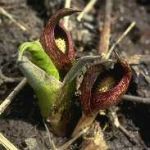| Common Name: |
Polecat Weed |
| Other Names: |
Skunk Cabbage |
| Botanical Name: |
Symplocarpus foetidus |
| Genus: |
Symplocarpus |
| Family: |
Araceae |
| Location: |
Northeastern N America. |
| Cultivation: |
Deep, rich, moist to wet, lime-free soil in sun or shade. Does not transplant easily. |
| Propagation: |
By seed kept wet until sown in autumn or spring; by division of large clumps during dormancy. Seedlings are slow-growing and dislike disturbance. |
| Harvest: |
Rhizomes and roots are lifted during dormancy and dried for decoctions, infusions, liquid extracts, powders, and tinctures. |
| Height: |
75cm (30in) |
| :Width |
75cm (30in) |
| Hardiness: |
Z3-7 |
| Parts Used: |
Rhizomes, roots |
| Properties: |
A pungentm warning, anti-spasmodic, sedative herb with a fetid odor. It acts as an expectorant and diuretic, and increases perspiration. |
| Medicinal Uses: |
Internally for bronchitis, asthma, whooping cough, mucus, hay fever, and irritating coughs. Combines well with Grindelia camporum (See, Gumweed) and Euphorbia hirta (See, Asthma Weed) for bronchitis and asthma. |
| Warning: |
Excess causes vomiting |
| Bibliography: |
Encylopedia of Herbs by Deni Brown Copyright ©: 1995, 2001 Dorling Kindersley Limited pp.377-378
|

